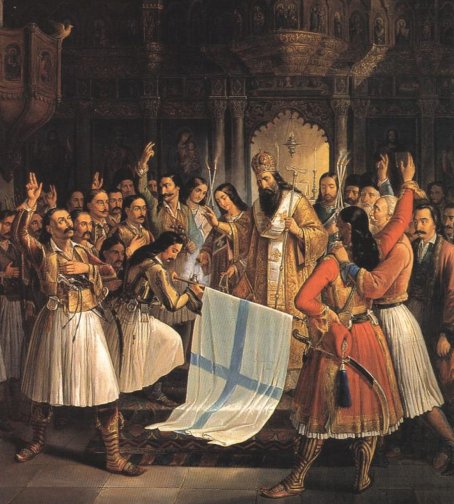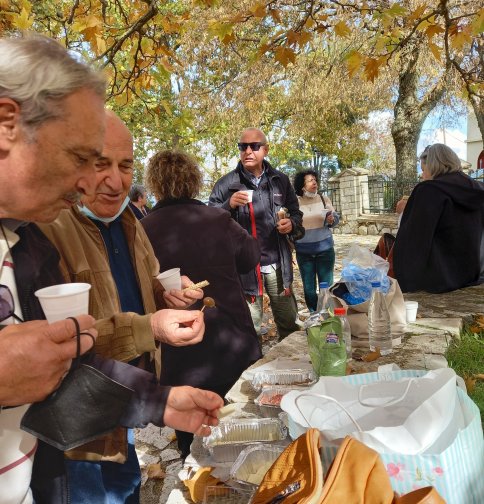EXCURSION to KALAVRYTA

The CULTURAL SOCIETY LONGOS "LORD BYRON" in cooperation with MATTHEOS-TOURS - Aigio organised a one-day EXCURSION to KALAVRYTA
|

|
|
Service charge: € 13,00 per person. The journey from Kalavryta to Diakopto can be made by rack railway. Additional contribution: € 7,10. The total amount is to be paid at the time of registration. Registration until Thursday, 4 November.
Further information and registration:
All measures against the pandemic will be complied with.
(Evidence of vaccination or recovery or rapid test required)
Excursion programme November 14, 2021 |
 |
 |
During the late Middle Ages, the town was the centre of the Barony of Kalavryta within the Frankish Principality of Achaea, until it was reconquered by the Byzantines in the 1270s. After that it remained under Byzantine control until the fall of the Despotate of the Morea to the Ottoman Turks in 1460. With the exception of a 30-year interlude of Venetian control, the town remained under Turkish rule until the outbreak of the Greek War of Independence in 1821, in whose early stages Kalavryta figures prominently: it was here that on 21 March 1821 the flag of the revolt was raised at the monastery of Agia Lavra by bishop Germanos III of Old Patras.
At the end of 1943, near Kalavryta, 81 German soldiers, led by Hauptmann Johannes Schober, were captured by Greek partisans. Four Germans were killed on the spot. Three were taken to hospital at Kalavryta but were later shot by the furious partisans. The rest were initially treated as prisoners of war until most were shot dead and some plunged over the cliff near Mazi from the force of the shots. Two German prisoners survived the execution and raised the alarm on the following day 8 December 1943.
Massacre of Kalavryta
On 13 December 1943, in retribution for the killing of the captured German soldiers, the Massacre of Kalavryta took place. German troops ordered all male residents of Kalavryta, aged 14 years and up, to gather in a field just outside the village. Some 1 300 women and girls were locked in a school which was then set on fire while the men were looking on from a hill outside the village. Fortunately for the women, an Austrian soldier unlocked the door of the building and the women and girls managed to escape. The Germans shot the soldier who had set them free. Then 696 boys and men were machine-gunned. Only 13 survived. After that, they burnt down the town before they left and the next day they burnt down the monastery of Agia Lavra, the birthplace of the Greek War of Independence. After the war, the federal government of Germany offered gestures of atonement in the form of free school books for the high school, scholarships for orphans of the massacre and the building of a retirement home. However, German commanders, including Major Ebersberger who carried out the destruction of Kalavryta and Hauptmann Dohnert who led the firing party, were never brought to justice for their crimes.
Every year on December 13, the inhabitants of Kalavryta gather below the cross and the victims are commemorated by reading out their names.
The clock of the left church tower has stopped at 13:34 since the massacre.
 |
 |
The rooms of the old primary school now house the "MUNICIPAL MUSEUM OF THE KALAVRYTAN HOLOCAUST".
Municipal Museum of the Kalavrytan Holocaust Learn more ...
The Kalavryta region also became the site of fighting during the Greek Civil War. On 11 April 1948, Kalavryta was seized by the Democratic Army of Greece (DSE) after the former overpowered the town's garrison. DSE released 17 leftists held in the local gendarmerie building, while also emptying the national guard and United Nations Relief and Rehabilitation Administration warehouses; taking 400 million drachmas and large quantities of food and military equipment in the process.
It was burnt to the ground in 1585 by the Turks. It was rebuilt in 1600 while the frescoes by Anthimos were completed in 1645. It was burnt again in 1715 and in 1826 by the armies of Ibrahim Pasha of Egypt. In 1850 after the rebirth of modern Greece, the building was completely rebuilt. The monastery was burned down by German forces in 1943.
It is famously linked with the Greek War of Independence, since it was here that the call for Eleftheria I Thanatos (Ελευθερία ή θάνατος) was first heard on 25 March 1821, launching the revolution against the Ottoman Empire. That day, Bishop Germanos of Patras performed a doxology and administered an oath to the Peloponnesian fighters. The revolutionary flag was raised by Bishop under the plane tree just outside the gate of the monastery.
To this day, the vestments of Germanos, documents, books, icons, the Gospel of Tsarina Catherine II of Russia, sacred vessels, crosses, etc. are preserved in the Monastery's museum, along with the holy relics of St Alexios, given by Byzantine emperor Manuel II Palaeologus in 1398. Pieces of embroidery, made with gold or silver threads woven in pure silk materials in Smyrna and Constantinople, are also possessions of the Monastery and they date from the 16th century.
 |
 |
The monastery is located in a large cave in a sheer cliff, where the western slopes of Mount Chelmos drop down to the gorge of the Vouraikos river, some 11 kilometres (6.8 mi) northwest of the town of Kalavryta. The cave was known in antiquity, and the geographer Pausanias reports that the daughters of Proetus found refuge there during their madness. In the first Christian centuries, Christian hermits occupied the cave.
According to tradition, the monastery is one of the oldest in Greece, reputedly founded in 362 by the Thessalonian brothers Symeon and Theodore, who with the help of Euphrosyne (a local shepherdess, honoured as saint for her part in these events) discovered in the cave the icon of the Theotokos painted by Luke the Evangelist.
Its medieval history under Byzantine and Latin rule is obscure. The monastery gained prominence only from about 1354, when it served as the residence of the Orthodox Metropolitan of Patras, since the city was still occupied by the Latins and the seat of a Latin archbishopric. The complex suffered large-scale destructions in 849, 1400, and 1640, when it was comprehensively rebuilt.
Several of the monks became members of the Filiki Etaireia and took part in the Greek War of Independence. In 1934, the katholikon was destroyed in a fire, and replaced by a new church in 1937. On 8 December 1943, the German 117th Jäger Division destroyed the monastery and executed 22 monks and visitors as part of reprisals that culminated a few days later with the Massacre of Kalavryta.
The monastery was rebuilt from the ground after the war, and now comprises an eight-storey complex set in the 120 metres (390 ft) high cliff face. A male monastery, it celebrates on August 15 (the day of the Dormition), September 14, and October 18 (Luke the Evangelist).
 |
 |
 |
 |
 |
 |